Minority Village Tours
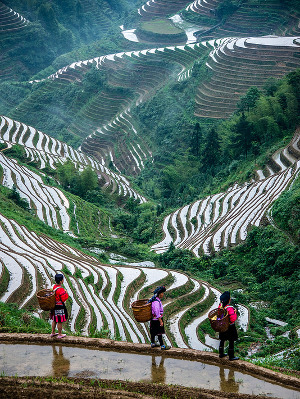
Longsheng and Sanjiang
The Longji rice terraces are one of the most popular attractions in China. They are located about 100 kilometers (about 60 miles) north of Guilin. The Longji terraces were begun in the Yuan Dynasty and completed in the Qing Dynasty by the Zhuang and Yao ethnic minority tribes. The fields cover an area of over 70 square kilometers. They stretch from 380 to 1180 meters above sea level -- a vertical rise of 800 meters (more than 2,500 feet). The scenery is spectacular in every season. The best time to visit is from spring to autumn.
Longji not only has unique scenery, but also boasts a rich variety of customs and culture from Yao, Miao, Dong, and Zhuang ethnic minority groups. This is a destination not to be missed!
One or two-day trip: To visit the rice terraces you can take a bus or hire a private car. The bus is less expensive, but you can't do a one-day trip, because it takes 6 hours to reach the terraces and you have to change buses 4 times. The private car or van takes only 3.5 hours, and you can stop anywhere you would like to take photographs. If you have 3 or 4 people share a car, the price is not much more than for the bus tickets, making it a more convenient and comfortable alternative. You can make a day trip or stay overnight to experience the Yao and Zhuang ethnic minority villages lifestyle and customs. The car can take you to the top of the hill; from there it's a pleasnt 20-minute walk to Ping'an village, which offers hotels and restaurants for tourists.
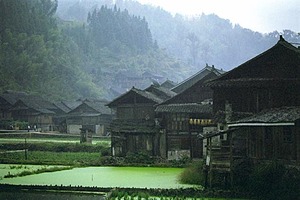
Guizhou
Guizhou is a province with 17 minority nationalities, including the Miao, Buyi, Dong, and Shui. Ethnic minority groups constitute 36.8% of Guizhou's population. Each minority has its own history, culture, customs and traditional festivals. They welcome tourists to enjoy traditional singing and handicrafts, including beautiful embroidered textiles, batiks, and weavings.
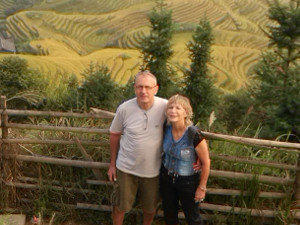
Full Nine-day Longsheng-Sangjing-Guizhou Minority Tour
Day 1: Yangshuo (Guilin) to Longji rice terraces (over night in Ping'an village).
Option 1: We meet you at the hotel at 8 a.m. and then take a private car to Longji, arriving about 2.5 hours later. On the way you can stop in the villages to take photographs. We will stop in the Yao village to see the Yao ladies with their famous long hair (by some accounts, the longest in the world). The Yao people wear colorful clothes with different embroidery designs, long earrings, and special hair styles. The last stop is Ping'an village, where you can hike up to the top of the hill to see the unique rice terraces and experience the Zhuang ethnic group's lifestyle, culture, and costumes. Young Zhuang ladies wear white skirts and black trousers; old ladies wear blue or black clothes, with brightly colored, embroidered headresses. Stay one night in Ping'an village.
Option 2: Our guide can pick you up at the Guilin airport, and drive with you in a private car to the Longji rice terrces, where you can spend the night.
Day 2: Longji to Sanjiang Chengyang Bridge, overnight in Dong village (Dong village hotel)
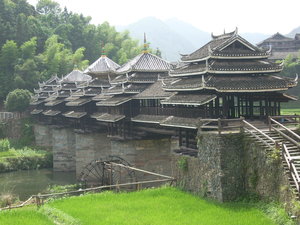
Wind and Rain Bridge in Sanjiang
A three-hour drive will take you to Sanjiang Chengyang Bridge, the famous "Wind and Rain Bridge" which was built in 1916 and is considered by the Dong to be the finest of the 108 such structures in Sanjiang county as well as a symbol of the Dong minority nationality.
The columns and towers of the bridge are all engraved with flowers and patterns, magnificent and splendid. More unique is that the whole bridge was built with wood, but no nails or rivets were involved in its construction. Stepping on the bridge, you will be amazed at the extraordinary architectural skills of the Dong people.
The bridge not only offers convenient transportion but also serves as a gathering place for temple fairs.
Visit the wooden houses, drum tower and drama tower in Dong village. Stay one night in Dong village hotel.
Day 3: Sangjiang-Zhaoxing, stay in Zhaoxing hotel
Drive to Zhaoxing Dong village. With a history of over 2000 years, this is the largest Dong ethnic village in China, housing more than 4,000 people and over 1,000 families.
Day 4: Zhaoxing Dong minority village
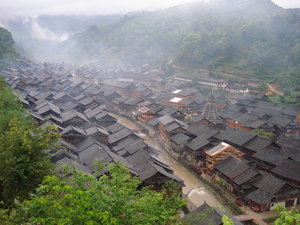
Zhaoxing Village
Walking around Zhaoxing Dong minority village, there are 5 Drum Tower and drama (opera) stages, 5 Wind and Rain Bridges and 3 Sa altars. Its drum towers are a recognized cultural heritage site in China and are entered in the Guiness Book of World Records.
The drum towers, bridges, opera stages, and Sa altars together represent the Dong people's architecture and spirituality. The five drum towers represent the five family branches that come together in one village. The old wooden buildings have been very well preserved and present the strong ethnic customs and hospitality of the Dong people.
Stay one more night in Zhaoxing hotel.
Day 5: Zhaoxing-Congjiang-Basha Miao village-Gaozeng Dong village, stay in Congjiang
Drive to Basha. Basha is an old Miao ethnic village. Residents still preserve and practice centuries-old customs.
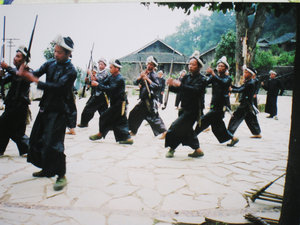
Basha Miao Men with Guns
The Miao are the last of the ethnic tribes who may legally carry guns in accordance with their traditions. The men continue to wear their hair long, periodically cutting it with a large ceremonial knife.
In the afternoon, you can visit Gaozeng Dong village, which has 600 years of history. It is especially famous for its drum towers. The highest tower has 17 storeys. At the end of the day, you will return for another stay in Congjian.
Day 6: Congjiang-Rongjiang-Dingdong Village (visit on market day)-Chejiang Dong village, stay in Rongjiang
Drive to Rongjiang. Then go to visit Dingdong market (which occurs on the 4th, 9th, 14th, 19th, 24th, and 29th days of each month on the Chinese lunar calendar). This is an interesting local market where members of many diffeent ethnic groups gather to trade their goods. In the afternoon, we will proceed to Chejian Dong village
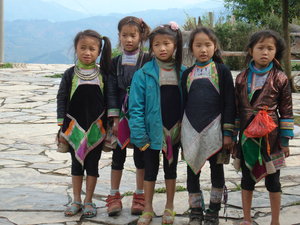
Miao Girls
Day 7: Rongjiang-Xijiang Miao Village, overnight in Xijiang
The drive to Xijiang takes 3 hours. Xijiang is the largest Miao village in China, with more than 6,000 people and over 1,150 families. It is famous for its silversmiths, handicrafts, and traditional folk celebrations. Stay in Xingjiang.
Day 8: Xingjiang-Langde -Kaili-Guiyang, stay in Guiyang
Drive to Langde. Langde village is home to a subgroup of the Miao known from their special dress as the "long skirt Miao." Built in the Yuan Dynasty, it is 640 years old and houses 128 families. There are 3 gates and 3 main streets. The southern end of the village offers a "guard hill" and museum, while the northern end has a "wind and rain bridge." After lunch, we will drive to Guiyang and stay overnight there.
Day 9: Guiyang
Visit Hongfu temple in Qingling park, then drive to Guiyang airport for your next destination.
